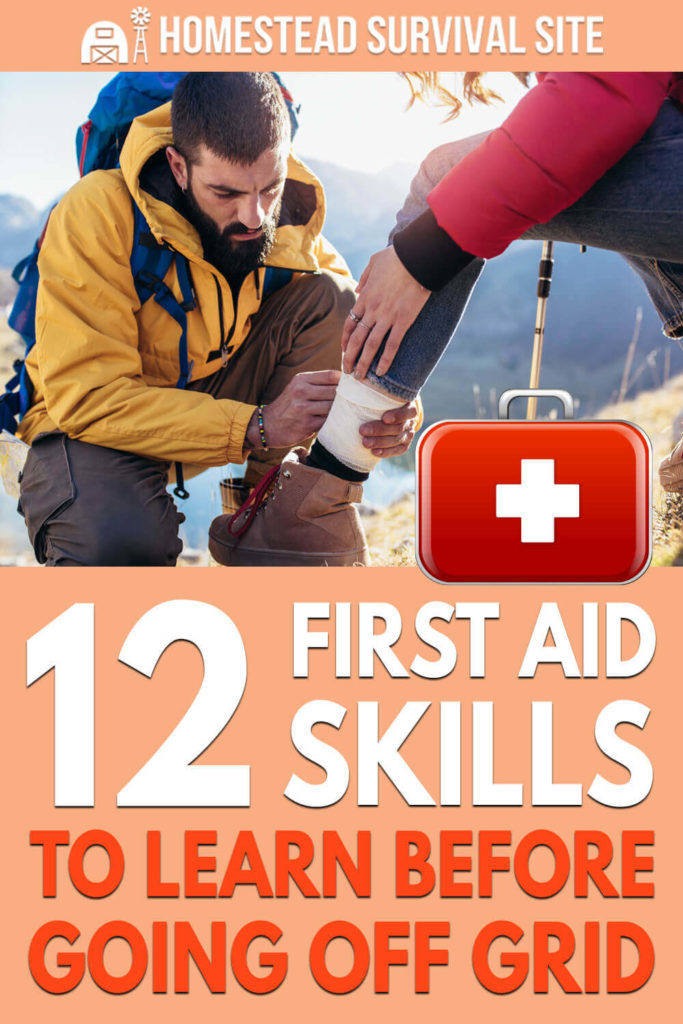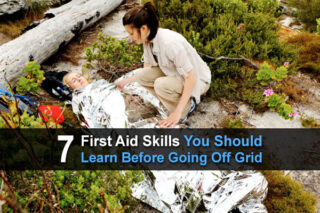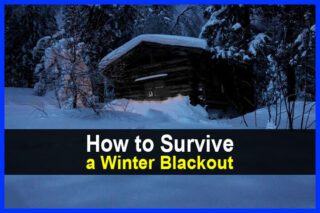Estimated reading time: 6 minutes
When someone gets injured, every single second is crucial. The longer it takes for them to receive first aid, the more likely they are to die or have long-term problems caused by the injury. This is one of the downsides of living off the grid. In some places, it could take hours for responders to reach your location.
Fortunately, there are many common medical emergencies that you can learn to treat on your own. Yes, the thought of dealing with a life-threatening emergency sounds very dramatic and a little terrifying. But just like all things in life, once you practice and educate yourself, these situations will become less dramatic, less terrifying, and more a matter of procedure.
Prepare now so you can act quickly later. Here are 12 life-saving first aid skills you should learn.
Want to save this post for later? Click Here to Pin It On Pinterest!
1. Perform CPR
You’ve seen it on TV a hundred times, but do you know exactly what to do when an adult is unresponsive and not breathing? Take 4 minutes of your time to learn the simple steps of CPR so that there is no hesitation in a crisis moment.
And perhaps the most helpful CPR tip is to learn the exact pace for chest comprehensions.
CPR for babies and small children requires a more delicate touch with chest compressions and with the amount of breathing applied. Make sure you know how to do CPR on a baby properly in order not to cause any further damage.
2. Perform the Heimlich Maneuver
When someone is choking, you’ve got about 5 minutes to dislodge whatever is blocking his or her airways before brain damage occurs. Learning how to do the Heimlich Maneuver on another person is a skill everyone should know.
The Heimlich Maneuver for children, however, is a bit different with their smaller bodies and requires an altered approach.
3. Give Sutures and Stitches
Fun Fact: In medical school, students practice suturing on bananas as the thickness of banana skin can be similar to that of a human!
You’ll learn that there are many different styles of sutures and stitches–each appropriate for different wounds and surgical procedures. Having the correct medical tools for sutures on hand will reduce your risk of infection.
4. Set a Splint
In order for broken bones to heal, it is imperative that they are set. In other words, the bones can't be allowed to move or they won’t fuse back together. Using an aluminum splint, set with an ace bandage will do the trick.
You can learn how to apply a splint here. You’ll also learn how to innovate when you need to make a splint out of household items in emergency situations.
5. Support a Sprain
Survival situations take a heavy toll on your body. Even those super humans who are fit as a fox will experience the occasional rolled ankle or twisted knee–but you’ve got to keep going.
Wrapping a sprained joint with an ace bandage will help ease the pain when you absolutely must carry on. When you have time to rest, it’s best to take it easy in an effort to spare yourself long-term cartilage and tissue damage.
6. Soothe a Heart Attack
Some heart attacks you don’t come back from and some, if you’re lucky, are minor. When you’re out in the wilderness or 5 hours away from the nearest hospital, all you can do is chew an aspirin and follow a simple Heart Attack First Aid Check List of do’s and don’ts. This will increase your chances of keeping the patient calm and conscious.
7. Spot and Control a Concussion
Oftentimes, concussions go unnoticed and wind up being silent killers. After a blow to the head, it’s important to know what symptoms to check for such as proper pupil dilation and coherence. Learn how to spot a concussion and what to do in order to control a concussion here.
8. How to Treat a First Degree Burn
First degree burns only effect the top layer of skin. The painful symptoms such as tenderness and mild swelling can be controlled by running cool water over the burn or popping an aspirin. These burns are easy to treat by applying topical remedies such as antibiotic ointment and wrapping with loose gauze. First Degree burns typically heal within 7-10 days.
9. How to Treat a Second Degree Burn
A second-degree burn is easy to identify with the presence of blisters and thickening of the skin. Immediately run the burned area under cool clean water for 15 minutes, but do not apply ice as it can tear off the delicate skin. Similar to first-degree burns, apply antibiotic ointment and loose gauze. Keep this area dry and clean.
10. How to Treat a Third Degree Burn
The most serious, and potentially life-threatening burns are third-degree burns. These burns are classified by overall whitening of the skin where the skin takes on an almost leathery appearance. These burns are deep and difficult to treat at home; some even require amputations. What you can do, however, is follow a Third Degree Burn Do’s and Don’s List.
11. Stop Someone from Bleeding Out
When a main artery or vein is nicked or severed, it takes only 10-15 minutes for a person to bleed out. Knowing how to stop severe bleeding until it can be properly sutured is a matter of life and death.
It never hurts to have a military grade tourniquet on hand for severe situations.
12. Treating Hypo- and Hyperthermia
Hypothermia is when your body loses heat faster than it can generate it. If you're cold enough, you could have a weak pulse, slurred speech, confusion, drowsiness, and even loss of consciousness. Most people's instinct is to immediately put the person next to a fire or in a hot bath, but it's important to get them back to the right temperature gradually. Here's how.
Hyperthermia, on the other hand, is when your body can't keep itself cool. This is commonly known has heatstroke, and in this case, you don't want to get them back to their right temperature gradually. Rather, you should cool them off as quickly as you can. Get them into some shade, remove excess clothing, put them in a cool bath, spray them with cool water, give them ice packs, and anything else you can think of to cool them down.
Final Thoughts
Remember that the key to survival is being well rounded in your survival skills. It’s not enough to have a fully stockpiled basement full of canned food, and it’s not enough to be a medical genius. You need a balance of information and tools to keep you and your family alive and thriving.
Just as you take the time to reinforce your windows and doors, you should take the time to read up on these life-saving skills for survival situations. For that, be sure to check out The Survival Medicine Handbook.
Take advantage of your resources now! While you have access to the Internet, watch as many First Aid tutorials as you can find and order some necessary first aid tools off of Amazon. What may take you a few hours today could potentially add years onto your life in the future.
Like this post? Don't Forget to Pin It On Pinterest!











There are approximately 6,500,000 parents with children under 5 in the UK – that’s a huge number. Research shows that parents with a young child are keen to learn some basic first aid skills – they are responsible for the safety of their child after all. If the worst happened, and you found yourself in a first aid situation, wouldn’t you want to know the right way to do things, to know that you were doing the best for your child while waiting for professional help?